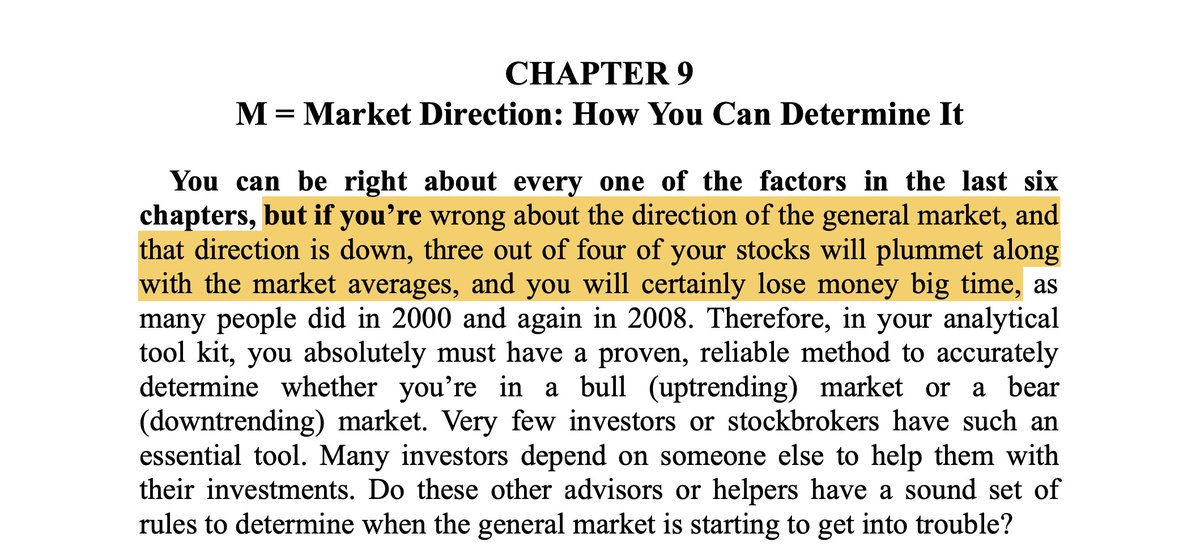By the end of this thread, you'll know how to:
1. Build an objective list of buy criteria
2. Have 10+ real world examples to study
3. Increase your win rate.
4. Increase your profitability
Let's dive in!
Buy Rule #1: The General market must be in an uptrend.
3 out of every 4 stocks follow the market trend both to the upside and to the downside.
This means that if you are buying a breakout in a downtrend, it already has a 75% chance of failing!
It doesn't matter if the stock is in a leading group with an impressive RS line and strong fundamental story.
At the end of the day, market direction is the MOST important factor!
Here's an excerpt from How To Make Money In Stocks by stock market legend William O'Neil:
Here's another video by
@richardmoglen that will help you determine if the stock market is in a downtrend:
https://t.co/shD5OjkP6s Let's move on to #2.
@RichardMoglen Buy Rule #2: The stock itself is in an uptrend.
Just like the general market, we want the stock to be in an BEFORE we go to purchase it.
This will ensure that we are not trying to swim upstream against a current of massive sellers.
@RichardMoglen How do we determine if a stock is in an uptrend?
✅ It is above its 10, 21, 50, and 200-day moving averages
✅These moving averages have a positive slope
✅ The stock is forming higher highs and higher lows
That's it! Keep it simple.
@RichardMoglen Here are some current examples of stocks in uptrends:
$OXY
$DVN
$HDSN
$SLVM
We want to jump on for the ride as stocks in longer term uptrends break out after a short term base/consolidation.
@RichardMoglen Buy Rule #3: The base of the stock in question matches one of O'Neil's well known basing structures.
William O'Neil studied the greatest winners in stock market history & found that the biggest winners had a recognizable basing structure BEFORE they made their massive runs.
@RichardMoglen Before purchasing, ask yourself if the stock you are about to buy fits into one of these base structures:
✅ Cup with Handle
✅ Cup without Handle
✅ Double Bottom
✅ Flat Base
✅ High Tight Flag (HTF)
✅ IPO Base
✅ Ascending Base
✅ Square Box
@RichardMoglen If you want to know more about these bases, here's a thread we did on the topic 👇
https://t.co/cxsTs0pLTb
@RichardMoglen Buy Rule #4: The stock in question must have a prior uptrend (unless it is an IPO) of at least 20%.
This is a simple rule. We are simply looking to see if the stock has been accumulated before.
@RichardMoglen Stocks that are under accumulation will usually find themselves under accumulation again in the future after a period of proper of basing.
Here are some examples:
$CHGG
$COUP
$SHOP
$EBAY
@RichardMoglen Buy Rule #5: Tight price action prior to the breakout attempt
It is very important for a stock to show volatility contraction before going to make a breakout attempt.
Why? Keep reading & we'll tell you 👇
@RichardMoglen · Tight price action before breakout allows us to DEFINE OUR RISK.
· Tight price action before breakout shows institutions are tightly holding stock, another key point for the retail investor.
· Tight price action tells us sellers are being absorbed.
@RichardMoglen Here are some great examples of stocks that got incredibly tight before they broke out 🔎
$CDLX
$BLD
$INMD
* A good clue to look for before a breakout occurs is an inside bar. This chart pattern tells us price is about to break - one way or the other.
@RichardMoglen Buy Rule #6: Uptrending RS line that confirms the break out by LEADING price higher.
This rule is nuanced but nevertheless very important.
At all points in our hunt for the best buy, we want our stock to be showing relative strength compared to the general mkt.
@RichardMoglen What you should be looking for in terms of the RS line when the stock breaks out:
✅ RS Line slope is bottom left to upper right, the stronger the better
✅ RS breaks out before price does (best case scenario)
✅ RS breaks along with price (still strong)
@RichardMoglen Here is a presentation by
@jfahmy given at the 2021 Virtual Trading Conference covering all things Relative Strength. 👇
https://t.co/6wXjPeT4N5
@RichardMoglen @jfahmy We have another video from
@RichardMoglen covering how to pick stocks by using a technique called the Relative Strength Phase 👇
https://t.co/WBHLjAhjOX
@RichardMoglen @jfahmy Buy Rule #7: The Stock is in a leadership group.
Nearly 50% of a stock's move is correlated to its respective industry group.
This means that if you're purchasing a stock in hopes of it being a big winner, you must have the industry group strength behind the move.
@RichardMoglen @jfahmy This is one of the key elements that Stan Weinstein, the author of Secrets for Profiting in Bull and Bear Markets, looked for.
Considering two stocks, and all else being equal, choose the one in the stronger group.
His Forest to the Trees approach:
https://t.co/xQJNB0otGr
@RichardMoglen @jfahmy Buy Rule #8: Volume requirements 👇
At the very least, your stock should be trading at least 400,000 shares on average over the past 20 sessions & be over $10.
This tells us that the stock is a liquid name that institutions can position in.
@RichardMoglen @jfahmy Additionally, when your stock goes to breakout, it should be trading on at least 2x relative volume compared to the average over the past 20 sessions.
This tells us that demand is strong through the pivotal point - increasing the odds of a successful breakout.
@RichardMoglen @jfahmy Here are some examples of successful breakouts and their end of day volume:
$ARWR - 10x volume
$TWLO - 9x volume
$TTD - 12x volume
@RichardMoglen @jfahmy Buy Rule #9: Higher timeframes should be breaking out as well.
The higher the timeframe, the more impactful the move will be.
If you trade on a daily timeframe, it is important to see if price is breaking out on the weekly & monthly timeframes as well.
@RichardMoglen @jfahmy The ideal scenario is when the stock is in a strong uptrend on the monthly chart but has been basing for multiple months or weeks constructively.
Then the stock approaches the top of the base and breaks through pivots on both the daily, weekly, and monthly chart on volume.
@RichardMoglen @jfahmy Making sure you have longer timeframes in mind will help you determine the amount of overhead supply (or lack-thereof) & determine whether the stock you are going to purchase has a high likelihood of a strong breakout and trend!
Let's move on to our last rule!
@RichardMoglen @jfahmy Buy Rule #10: Lower time frames should also be breaking out.
If you normally trade on the daily timeframe, this means that a 65-minute, 30-minute, or 15-minute chart is also breaking out.
This ensures that all timeframes are in agreement and the short term trend is with you.
@RichardMoglen @jfahmy Just like on the longer timeframes, we want to see a period of lower volatility right before the breakout occurs on a lower timeframe.
This allows us to manage risk tightly, keeping our losses small if the stock fails to break out.
@RichardMoglen @jfahmy To sum it all up, every buy you make should satisfy the following 10 criteria:
1️⃣ General market is in an uptrend
2️⃣ The stock is in an uptrend
3️⃣ Well-known base
4️⃣ Stock must have prior uptrend
5️⃣ Tight price action prior to BO
@RichardMoglen @jfahmy 6️⃣ Uptrending RS Line
7️⃣ Stock is in a leadership group.
8️⃣ Volume requirements
9️⃣ Higher timeframe BO
🔟 Lower timeframe breakouts
@RichardMoglen @jfahmy Start implementing these rules into your buying techniques and you are sure to see...
· Increased Confidence
· More profits
· A Higher batting average
@RichardMoglen @jfahmy That's it!
If you enjoyed this thread:
1. Follow
@TraderLion_ for WEEKLY threads on investing, the stock market, and more!
2. RT the tweet below to share this thread with your audience
3. Enjoy the rest of your weekend! 🦁
https://t.co/n35jYxCORa






